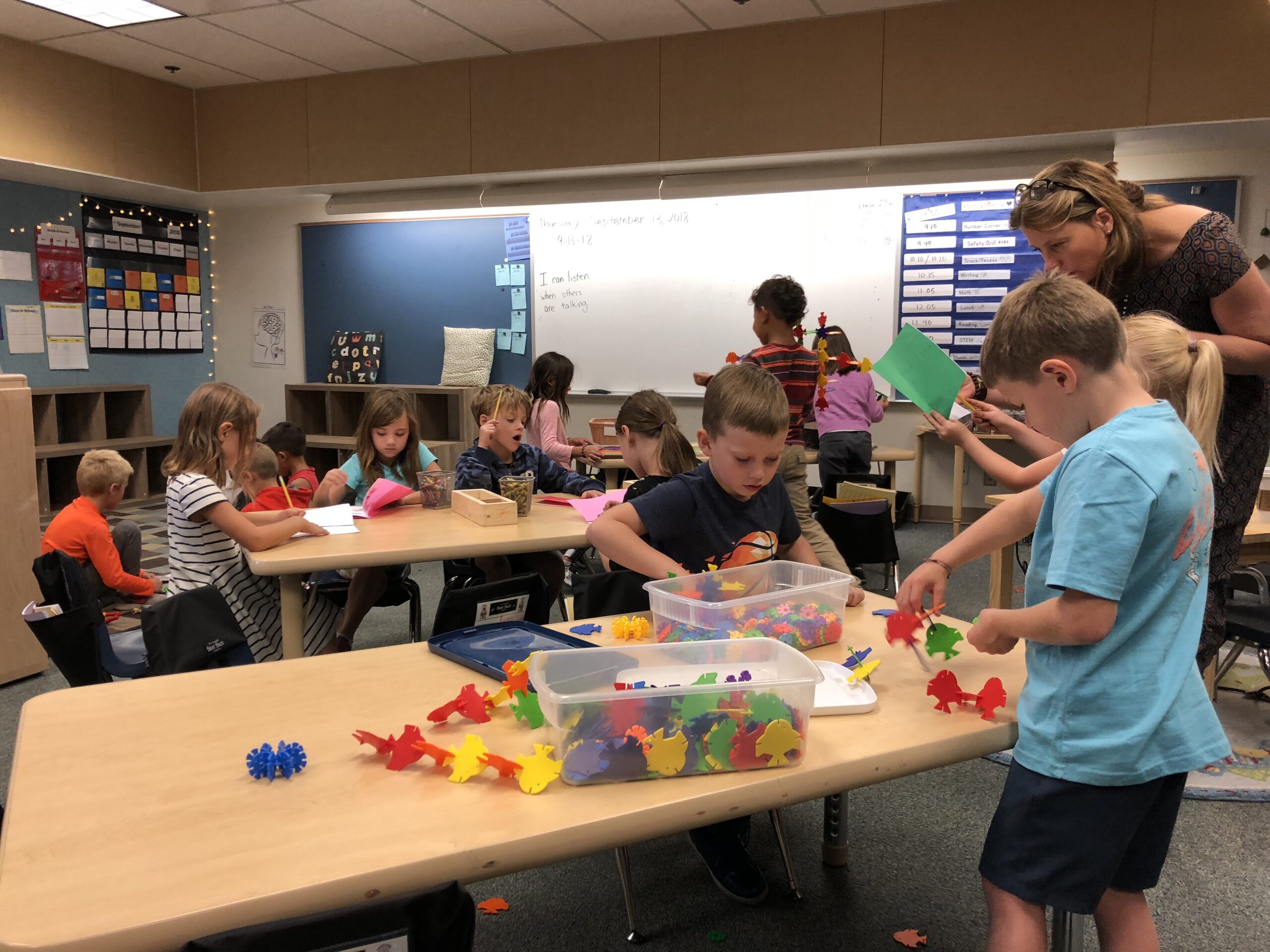
Small by Design: What Big Systems Can Learn from Microschools
Microschools are rethinking what it means to scale by showing that sometimes the biggest impact begins small.
It is a few weeks into the school year at Flourish Schools in Nashville. In a bright, flexible classroom tucked inside a renovated office building, seven middle schoolers are reflecting on curiosity. They call it a “superpower,” one of the skills and mindsets they practice daily. The school’s founders, John Danner and Adam Nadeau, designed Flourish to measure what many schools overlook: a student’s ability to stay curious, collaborate, and persist in a world that is changing faster than any single curriculum can keep up with.
Flourish blends project-based learning, social-emotional growth, and technology-enabled feedback to help learners develop these “superpowers.” Each student’s progress is guided by educators who know them well and by AI tools that support skill tracking and reflection. It is part of a growing wave of microschools that are small by design and built to show that personalized learning can be both rigorous and deeply human.
Across the country, microschools like Flourish are reframing the conversation about scale. For decades, education systems have equated size with impact. Bigger schools, larger districts, and standardized programs were considered the hallmarks of efficiency. But microschools are proving that small can be scalable — that systems can expand their reach not by growing larger, but by growing smarter.
Through our work with microschools and public systems, we have seen how the most meaningful innovations often begin in settings where every learner is known, where educators can adapt quickly, and where community and curiosity fuel achievement. “Small by design” is not a retreat from systemwide progress. It is a strategy for achieving it.
Scaling Depth Before Breadth
Microschools are no longer a niche idea. They have become one of the most visible movements in education innovation, representing both new starts and internal pilots across districts and networks.
Recent research from RAND found that 90 percent of microschool leaders report higher levels of student engagement and belonging compared to previous settings. The National Microschooling Center estimates that more than 1.5 million students could be enrolled in microschools by 2030, and that a majority of new founders are educators who left traditional systems in search of flexibility and purpose.
What these leaders are building offers important lessons for public education. Scaling is not about replication; it is about translation. The best microschools do not simply grow bigger. They deepen their impact and invite others to adopt their design principles.
Districts like Issaquah School District in Washington and Myrtle Elementary in California’s Escondido School District are proving that microschooling can exist inside public systems. Each district has created a “school within a school,” where small teams of teachers pilot flexible schedules, advisory systems, and project-based units. These pilots have become laboratories for testing ideas that can later spread across the district.
At Issaquah, educators are learning how micro communities can strengthen student belonging and mentorship. At Myrtle Elementary, a small team of teachers has redesigned instructional time to emphasize collaboration, self-direction, and connection to local partners. These models give educators the freedom to design and the data to show that autonomy and accountability can coexist.
In Indianapolis, Purdue Polytechnic High Schools (PPHS) adds another dimension. PPHS is a public charter network that partners with Indianapolis Public Schools (IPS) through the district’s Innovation Network framework. Within this model, PPHS launched its Lab Microschool, which serves as an incubator for personalized learning inside a larger system. Students move through flexible pathways, engage with mentors from Purdue University, and participate in real-world projects connected to local industries.
Together, these examples illustrate how microschools can operate as both standalone models and embedded catalysts. They are helping districts prototype what the future of learning could look like — smaller, more personalized, and more agile.
What Big Systems Can Learn
The microschool movement offers a blueprint for systems seeking to improve learning outcomes, engagement, and equity. The lessons are practical, not theoretical.
1. Pilot with purpose
Microschools function as living R&D labs. They give districts a low-risk way to test new learning models before scaling them systemwide. Districts can start small, trying new competency-based pathways, rethinking credit systems, or experimenting with advisory-based models. These pilots provide the evidence and confidence leaders need to make larger structural changes.
2. Design for flexibility
Many microschools emerged as a response to rigid policies and post-pandemic attendance challenges. By creating smaller communities and flexible schedules, schools can re-engage learners who struggled to thrive in traditional settings. Some microschools operate hybrid programs that allow students to attend in person several days a week and work independently on others. This flexibility supports diverse learners, from students balancing family responsibilities to those pursuing internships or specialized interests.
3. Serve niche populations with intention
Microschools are often designed around specific learner needs or interests. Some focus on students who need trauma-informed environments. Others emphasize career-connected learning, global studies, or outdoor education. Large districts can replicate this intentionality by developing specialized academies or programs that serve smaller groups of students within larger schools. The result is a more inclusive, customized experience that can increase retention and success.
4. Build modular, not monolithic, systems
Big systems tend to grow in layers, adding programs without redesigning the structure beneath them. Microschools flip that logic. They are modular by nature — small learning communities that can adapt to their context while sharing a set of guiding principles. Districts can learn from this approach by organizing schools into clusters, houses, or interdisciplinary pods that balance autonomy with shared vision. The Public Microschool Playbook, developed with Transcend and Learner-Centered Collaborative, provides tools and frameworks for leaders ready to embed these principles into existing systems.
5. Redefine accountability and accreditation
The most persistent barrier to innovation is not imagination. It is regulation. Seat-time rules, Carnegie units, and compliance-based accountability systems measure attendance rather than learning. States like Indiana are showing a different path. Through new flexibility waivers and pilot programs, districts are testing mastery-based approaches that prioritize student outcomes and competency over time spent in a chair.
Accrediting bodies are also adapting. The Middle States Association’s Next Gen Accreditation (NGA) pilot, now in its second year, allows schools to demonstrate quality through evidence of learner agency, well-being, and growth. Fifteen schools are currently in candidacy, with dozens more preparing to apply by spring 2026. This model creates legitimacy for microschools and validates innovation as a credible route to quality, not a deviation from it.
6. Provide enabling infrastructure
Microschools thrive on autonomy, but they also benefit from shared infrastructure. Larger systems can provide that support through shared back-office services, technology platforms, and professional learning communities. This partnership preserves the intimacy of microschools while offering the stability and capacity of larger organizations. Getting Smart’s Innovation Framework outlines how organizations can move from pilot to prototype to platform while keeping design principles intact.
Policy Momentum and System Shifts
Policy is slowly catching up to practice. Indiana’s legislative work around competency-based pathways and flexible attendance policies is setting a precedent for other states. Accreditation pilots like NGA are redefining what high-quality evidence looks like. Together, these shifts are beginning to move education policy from a stance of permission to one of empowerment.
Through our Public Microschool Community of Practice, we are seeing the field embrace this shift firsthand. District leaders, microschool founders, and nonprofit partners meet regularly to share lessons about implementation, regulation, and sustainability. These conversations often center on common barriers — such as outdated funding models or restrictive accountability rules — and generate strategies to address them collectively.
This community is proving that innovation does not have to happen in isolation. The most promising progress occurs when microschools and districts collaborate to solve shared challenges. One school’s pilot can become another’s policy precedent. One community’s model can inspire a state’s new framework. The ripple effect is already visible.
The Human Side of Scale
At the heart of every microschool is a relationship network. When teachers know every student well, they can adapt learning to meet academic and emotional needs simultaneously. Families feel connected to educators and to one another. Students develop a sense of belonging that translates into engagement and motivation.
These qualities are not exclusive to small schools, but they are easier to design for in small settings. Large systems can learn from this relational architecture. Advisory models, teacher looping, and community partnerships are practical strategies that can scale empathy and connection without requiring every school to shrink in size.
Flourish Schools calls these relational skills “superpowers.” They are not just for students. They are also what systems need most: curiosity, collaboration, and persistence. The same qualities that help a middle schooler tackle a project on environmental design can help a district leader navigate change.
Source link



